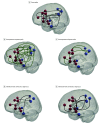Association of Childhood Violence Exposure With Adolescent Neural Network Density
- PMID: 32965498
- PMCID: PMC7512058
- DOI: 10.1001/jamanetworkopen.2020.17850
Association of Childhood Violence Exposure With Adolescent Neural Network Density
Erratum in
-
Error in Subject Area.JAMA Netw Open. 2020 Dec 1;3(12):e2031600. doi: 10.1001/jamanetworkopen.2020.31600. JAMA Netw Open. 2020. PMID: 33284332 Free PMC article. No abstract available.
Abstract
Importance: Adverse childhood experiences are a public health issue with negative sequelae that persist throughout life. Current theories suggest that adverse childhood experiences reflect underlying dimensions (eg, violence exposure and social deprivation) with distinct neural mechanisms; however, research findings have been inconsistent, likely owing to variability in how the environment interacts with the brain.
Objective: To examine whether dimensional exposure to childhood adversity is associated with person-specific patterns in adolescent resting-state functional connectivity (rsFC), defined as synchronized activity across brain regions when not engaged in a task.
Design, setting, and participants: A sparse network approach in a large sample with substantial representation of understudied, underserved African American youth was used to conduct an observational, population-based longitudinal cohort study. A total of 183 adolescents aged 15 to 17 years from Detroit, Michigan; Toledo, Ohio; and Chicago, Illinois, who participated in the Fragile Families and Child Wellbeing Study were eligible for inclusion. Environmental data from birth to adolescence were collected via telephone and in-person interviews, and neuroimaging data collected at a university lab. The study was conducted from February 1, 1998, to April 26, 2017, and data analysis was performed from January 3, 2019, to May 22, 2020.
Exposures: Composite variables representing violence exposure and social deprivation created from primary caregiver reports on children at ages 3, 5, and 9 years.
Main outcomes and measures: Resting-state functional connectivity person-specific network metrics (data-driven subgroup membership, density, and node degree) focused on connectivity among a priori regions of interest in 2 resting-state networks (salience network and default mode) assessed with functional magnetic resonance imaging.
Results: Of the 183 eligible adolescents, 175 individuals (98 girls [56%]) were included in the analysis; mean (SD) age was 15.88 (0.53) years and 127 participants (73%) were African American. Adolescents with high violence exposure were 3.06 times more likely (95% CI, 1.17-8.92) to be in a subgroup characterized by high heterogeneity (few shared connections) and low network density (sparsity). Childhood violence exposure, but not social deprivation, was associated with reduced rsFC density (β = -0.25; 95% CI, -0.41 to -0.05; P = .005), with fewer salience network connections (β = -0.26; 95% CI, -0.43 to -0.08; P = .005) and salience network-default mode connections (β = -0.20; 95% CI, -0.38 to -0.03; P = .02). Violence exposure was associated with node degree of right anterior insula (β = -0.29; 95% CI, -0.47 to -0.12; P = .001) and left inferior parietal lobule (β = -0.26; 95% CI, -0.44 to -0.09; P = .003).
Conclusions and relevance: The findings of this study suggest that childhood violence exposure is associated with adolescent neural network sparsity. A community-detection algorithm, blinded to child adversity, grouped youth exposed to heightened violence based only on patterns of rsFC. The findings may have implications for understanding how dimensions of adverse childhood experiences impact individualized neural development.
Conflict of interest statement
Figures


References
-
- Green JG, McLaughlin KA, Berglund PA, et al. . Childhood adversities and adult psychiatric disorders in the national comorbidity survey replication I: associations with first onset of DSM-IV disorders. Arch Gen Psychiatry. 2010;67(2):113-123. doi:10.1001/archgenpsychiatry.2009.186 - DOI - PMC - PubMed
-
- Hein TC. Dimensions of early adversity as distinct predictors of adolescent brain development. Published 2019. Accessed March 19, 2019. https://deepblue.lib.umich.edu/bitstream/handle/2027.42/149945/heint_1.p...
Publication types
MeSH terms
Grants and funding
LinkOut - more resources
Full Text Sources
Medical
Miscellaneous

